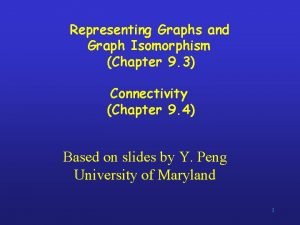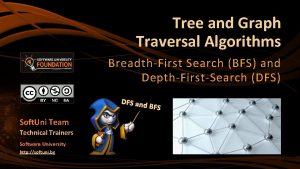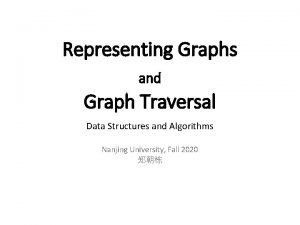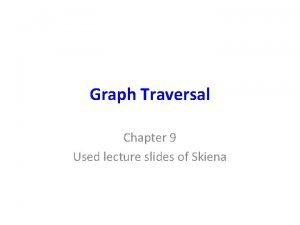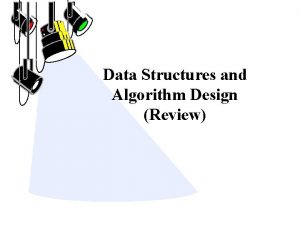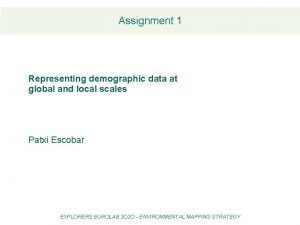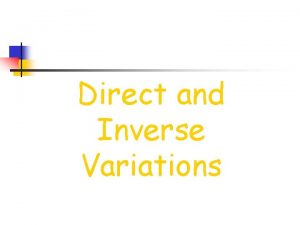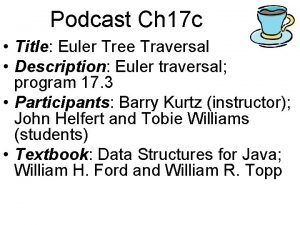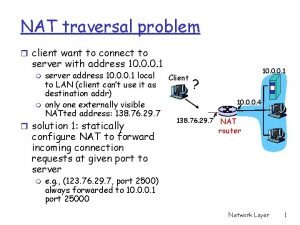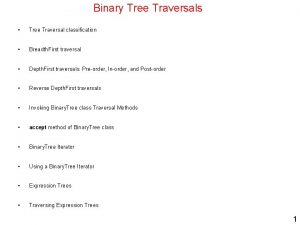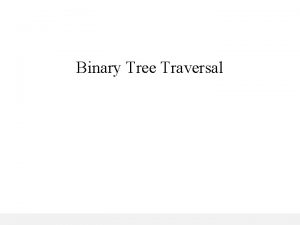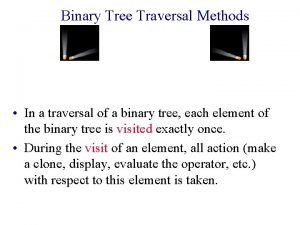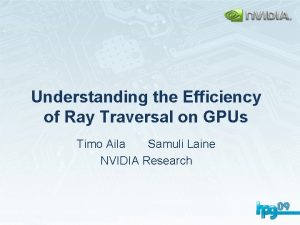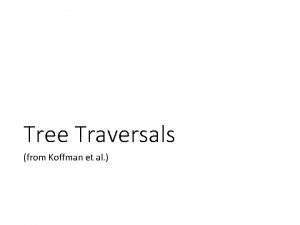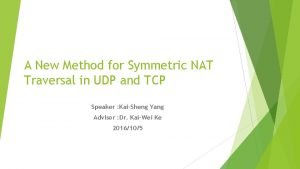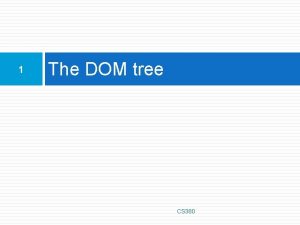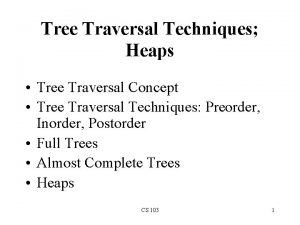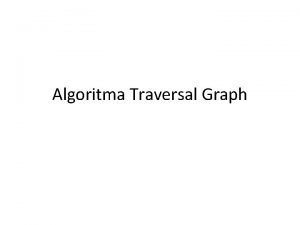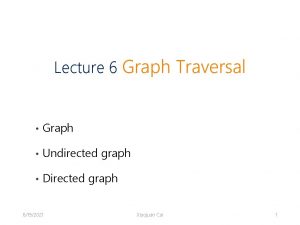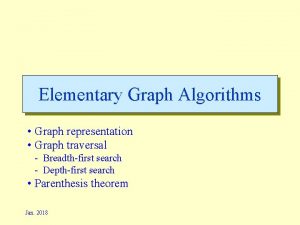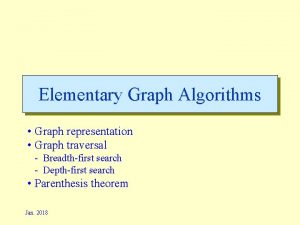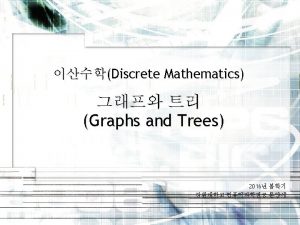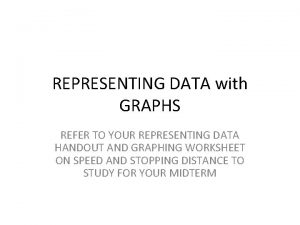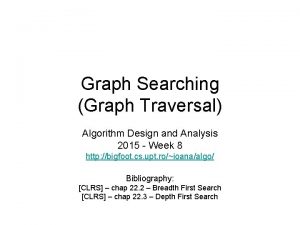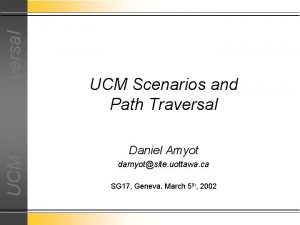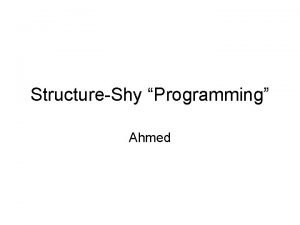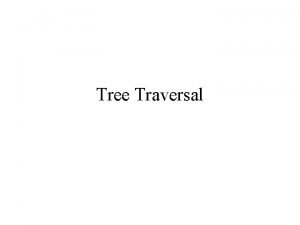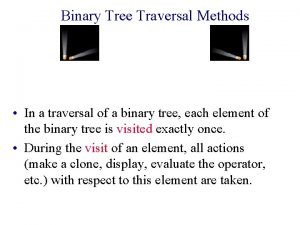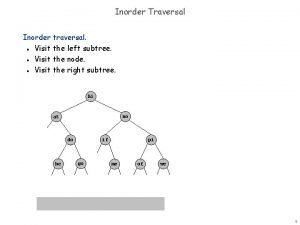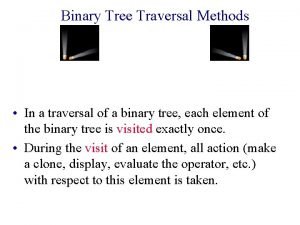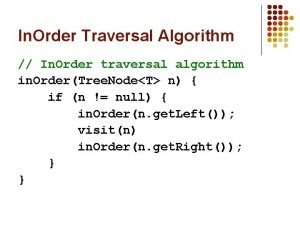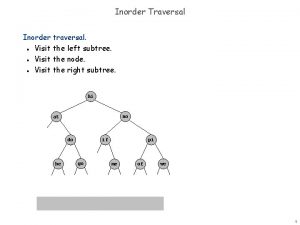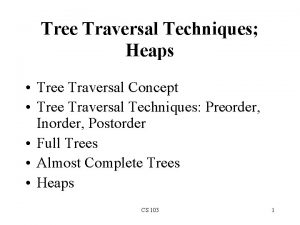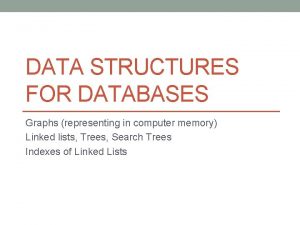Representing Graphs and Graph Traversal Data Structures and
































![Reading • [CLRS] Ch. 22 (22. 1 -22. 3) Reading • [CLRS] Ch. 22 (22. 1 -22. 3)](https://slidetodoc.com/presentation_image_h/0e190a7a28f659e3fca3226fd00e9821/image-33.jpg)
- Slides: 33

Representing Graphs and Graph Traversal Data Structures and Algorithms Nanjing University, Fall 2020 郑朝栋

Graphs are Everywhere! • Transportation Networks. • Nodes: Airports; Edges: Nonstop flights. • Communication Networks. • Nodes: Computers; Edges: Physical links. • Information Networks. • Nodes: Webpages; Edges: Hyperlinks. • Social Networks. • Nodes: People; Edges: Friendship. • …

Graphs are Everywhere! Really! • Coloring Maps. • Nodes: Countries; Edges: Neighboring countries. • Question of Interest: Chromatic number? • Scheduling Exams. • Nodes: Exams; Edges: Conflicts. • Question of Interest: Chromatic number? • Solving Sliding Puzzle. • Nodes: States; Edges: Legit moves. • Question of Interest: Shortest path? • Solving Rubik’s Cube. • Nodes: States; Edges: Legit moves. • Question of Interest: Diameter?

Representing graphs in computers Adjacency Matrix •

Representing graphs in computers Adjacency List •

Adjacency Matrix and Adjacency List Trade-offs •

Searching in a Graph (or, Graph Traversal) •

Breath-First Search (BFS) • These nodes are neighbors of distance 1 nodes!

BFSSkeleton(G, s): for (each u in V) u. dist=INF, u. visited=false s. dist = 0 Q. enque(s) while (!Q. empty()) u = Q. dequeue() How to implement BFS? (Hint: recall traversal-by-layer in trees) u. visited = true Use a FIFO Queue! for (each edge (u, v) in E) if (!v. visited) v. dist = u. dist+1 Q. enque(v) BFS Implementation • • • Nodes have 3 status: • Undiscovered (WHITE): Not in queue yet. • Discovered but not visited (GRAY): In queue but not processed. • Visited (BLACK): Ejected from queue and processed. • We can “store” a shortest path, instead of only the length of the path.

BFS Implementation BFS(G, s): for (each u in V) u. c = WHITE, u. d = INF, u. p = NIL s. c = GRAY, s. d = 0, s. p = NIL Q. enque(s) while (!Q. empty()) u = Q. dequeue() u. c = BLACK for (each edge (u, v) in E) if (v. c == WHITE) v. c = GRAY v. d = u. d+1 v. p = u Q. enque(v)

Sample Execution BFS(G, s): for (each u in V) u. c=WHITE, u. d=INF, u. p=NIL s. c=GRAY, s. d=0, s. p=NIL Q. enque(s) while (!Q. empty()) u = Q. dequeue() u. c = BLACK “else” clause? for (each edge (u, v) in E) { if (v. c == WHITE) v. c = GRAY first discovery v. d = u. d+1 (preprocessing) v. p = u Q. enque(v)}

Performance of BFS • BFS(G, s): for (each u in V) u. c=WHITE, u. d=INF, u. p=NIL s. c=GRAY, s. d=0, s. p=NIL Q. enque(s) while (!Q. empty()) u = Q. dequeue() u. c = BLACK for (each edge (u, v) in E) if (v. c == WHITE) v. c = GRAY v. d = u. d+1 v. p = u Q. enque(v)

Correctness and Properties of BFS • Will this really happen? !

Correctness and Properties of BFS •

One last note on BFS • What if the graph is not connected? • Easy, do a BFS for each connected component! BFS(G): for (each u in V) u. c = WHITE, u. d = INF, u. p = NIL for (each u in V) if (u. c == WHITE) u. c = GRAY, u. d = 0, u. p = NIL Q. enque(u) while (!Q. empty()) v = Q. dequeue() v. c = BLACK for (each edge (v, w) in E) if (w. c == WHITE) w. c = GRAY w. d = v. d+1 w. p = v Q. enque(w) Runtime of this procedure?

Depth-First Search (DFS) • Much like exploring a maze: • Use a ball of string and a piece of chalk. • Follow path (unwind string and mark at intersections), until stuck (reach dead-end or already-visited place). • Backtrack (rewind string), DFSSkeleton(G, s): until find unexplored neighbor s. visited (intersection with unexplored direction). = true for (each edge (s, v) in E) • Repeat above two steps. • if (!v. visited) DFSSkelecton(G, v) How to do this for a graph, in computer? • Chalk: boolean variables. • String: a stack. DFSIter. Skeleton(G, s): Stack Q Q. push(s) while (!Q. empty()) u = Q. pop() if (!u. visited) u. visited = true for (each edge (u, v) in E) Q. push(v)

A B A B D C D C A B A B A B D C D C D C BCDA A CBCDA A B A B D C D C BCDA DA CDA DFSSkeleton(G, s): s. visited = true for (each edge (s, v) in E) if (!v. visited) DFSSkelecton(G, v) DFSIter. Skeleton(G, s): Stack Q Q. push(s) while (!Q. empty()) u = Q. pop() if (!u. visited) u. visited = true for (each edge (u, v) in E) Q. push(v) A DA A B A B A B D C D C D C

Depth-First Search (DFS) • Q: What if the graph is not (strongly) connected? • A: Do DFS from multiple sources. DFSAll(G): for (each node u) u. visited = false for (each node u) if (u. visited == false) DFSSkeleton(G, u) DFSAll(G): for (each node u) u. visited = false for (each node u) if (u. visited == false) DFSIter. Skeleton(G, u) DFSSkeleton(G, s): s. visited = true for (each edge (s, v) in E) if (!v. visited) DFSSkelecton(G, v) DFSIter. Skeleton(G, s): Stack Q Q. push(s) while (!Q. empty()) u = Q. pop() if (!u. visited) u. visited = true for (each edge (u, v) in E) Q. push(v)

Depth-First Search (DFS) • DFSAll(G): for (each node u) u. color = WHITE u. parent = NIL for (each node u) if (u. color == WHITE) DFS(G, u) DFS(G, s): s. color = GRAY for (each edge (s, v) in E) if (v. color == WHITE) v. parent = s DFS(G, v) s. color = BLACK

A B E A B E D C F D C F A B E D C F A B E D C F DFSAll(G): for (each node u) u. color = WHITE u. parent = NIL for (each node u) if (u. color == WHITE) DFS(G, u) DFS(G, s): s. color = GRAY for (each edge (s, v) in E) if (v. color == WHITE) v. parent = s DFS(G, v) s. color = BLACK

Depth-First Search (DFS) • DFS provides (at least) two chances to process each node: • Pre-Visit: WHITE -> GRAY • Post-Visit: GRAY -> BLACK • Sample application: Track active intervals of nodes • Clock ticks whenever some node’s color changes. • Discovery time : when the node turn GRAY. • Finish time: when the node turn BLACK. DFSAll(G): Pre. Process(G) for (each node u) u. color = WHITE u. parent = NIL for (each node u) if (u. color == WHITE) DFS(G, u) DFS(G, s): Pre. Visit(s) s. color = GRAY for (each edge (s, v) in E) if (v. color == WHITE) v. parent = s DFS(G, v) s. color = BLACK Post. Visit(s) Pre. Process(G): time = 0 Pre. Visit(s): time = time+1 s. d = time Post. Visit(s): time = time+1 s. f = time

1, ? 2, ? A B A B A B D C D C D C 3, 4 3, ? 1, ? 2, 5 1, 8 2, 5 A B A B D C D C 3, 4 6, ? 3, 4 6, 7 3, 4 DFSAll(G): Pre. Process(G) for (each node u) u. color = WHITE u. parent = NIL for (each node u) if (u. color == WHITE) DFS(G, u) DFS(G, s): Pre. Visit(s) s. color = GRAY for (each edge (s, v) in E) if (v. color == WHITE) v. parent = s DFS(G, v) s. color = BLACK Post. Visit(s) Pre. Process(G): time = 0 Pre. Visit(s): time = time+1 s. d = time Post. Visit(s): time = time+1 s. f = time

Runtime of DFS • DFSAll(G): Pre. Process(G) for (each node u) u. color = WHITE u. parent = NIL for (each node u) if (u. color == WHITE) DFS(G, u) DFS(G, s): Pre. Visit(s) s. color = GRAY for (each edge (s, v) in E) if (v. color == WHITE) v. parent = s DFS(G, v) s. color = BLACK Post. Visit(s) Pre. Process(G): time = 0 Pre. Visit(s): time = time+1 s. d = time Post. Visit(s): time = time+1 s. f = time

Classification of edges • s u t w v


Properties of DFS Parenthesis Theorem •

Properties of DFS Parenthesis Theorem •

Properties of DFS White-path Theorem • WHITE -> GRAY ……

Properties of DFS White-path Theorem • ……

Properties of DFS Classification of edges •

Properties of DFS Types of edges in undirected graphs •

DFS, BFS, and others… DFSIter. Skeleton(G, s): Stack Q Q. push(s) while (!Q. empty()) u = Q. pop() if (!u. visited) u. visited = true for (each edge (u, v) in E) Q. push(v) BFSSkeleton. Alt(G, s): FIFOQueue Q Q. enque(s) while (!Q. empty()) u = Q. dequeue() if (!u. visited) u. visited = true for (each edge (u, v) in E) Q. enque(v) Graph. Explore. Skeleton(G, s): Generic. Queue Q Q. add(s) while (!Q. empty()) u = Q. remove() if (!u. visited) u. visited = true for (each edge (u, v) in E) Q. add(v) Other queuing disciplines lead to more interesting algorithms!
![Reading CLRS Ch 22 22 1 22 3 Reading • [CLRS] Ch. 22 (22. 1 -22. 3)](https://slidetodoc.com/presentation_image_h/0e190a7a28f659e3fca3226fd00e9821/image-33.jpg)
Reading • [CLRS] Ch. 22 (22. 1 -22. 3)
 Representing graphs and graph isomorphism
Representing graphs and graph isomorphism Representing graphs and graph isomorphism
Representing graphs and graph isomorphism Networks and graphs circuits paths and graph structures
Networks and graphs circuits paths and graph structures Graph traversal in data structure
Graph traversal in data structure Graph traversal in data structure
Graph traversal in data structure Bfs in discrete mathematics
Bfs in discrete mathematics Graph traversal methods
Graph traversal methods Testability tips in software testing
Testability tips in software testing Graphs that enlighten and graphs that deceive
Graphs that enlighten and graphs that deceive Tree traversal in data structure
Tree traversal in data structure Comparing distance/time graphs to speed/time graphs
Comparing distance/time graphs to speed/time graphs Which two graphs are graphs of polynomial functions?
Which two graphs are graphs of polynomial functions? Knowledge representation in data mining
Knowledge representation in data mining 11 interpreting graphics answers
11 interpreting graphics answers How are the whale flipper and the human arm different
How are the whale flipper and the human arm different Representing numerical data
Representing numerical data Representing numerical data
Representing numerical data Representing data assignment
Representing data assignment Algorithmic graph theory and perfect graphs
Algorithmic graph theory and perfect graphs Inverse variation
Inverse variation Wave algorithm in distributed system
Wave algorithm in distributed system Euler tree
Euler tree Nat traversal problem solution
Nat traversal problem solution Iterative inorder traversal
Iterative inorder traversal Reverse binary tree
Reverse binary tree Lcr is related to which tree traversal
Lcr is related to which tree traversal Tree traversal examples
Tree traversal examples Huffman tree traversal
Huffman tree traversal Understanding the efficiency of ray traversal on gpus
Understanding the efficiency of ray traversal on gpus Preorder traversal visualization
Preorder traversal visualization Symmetric nat traversal
Symmetric nat traversal Dom tree
Dom tree Heap traversal
Heap traversal Tree traversal
Tree traversal
